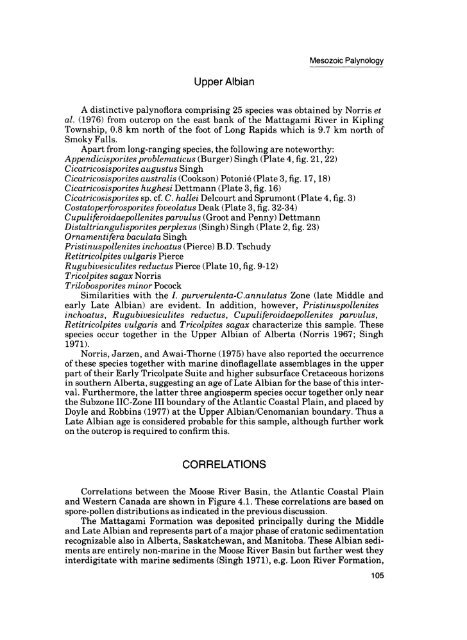Moose River Basin: geology and mineral potential - Geology Ontario
Moose River Basin: geology and mineral potential - Geology Ontario
Moose River Basin: geology and mineral potential - Geology Ontario
You also want an ePaper? Increase the reach of your titles
YUMPU automatically turns print PDFs into web optimized ePapers that Google loves.
Mesozoic Palynology<br />
Upper Albian<br />
A distinctive palynoflora comprising 25 species was obtained by Norris et<br />
al. (1976) from outcrop on the east bank of the Mattagami <strong>River</strong> in Kipling<br />
Township, 0.8 km north of the foot of Long Rapids which is 9.7 km north of<br />
Smoky Falls.<br />
Apart from long-ranging species, the following are noteworthy:<br />
Appendicisporites problematicus (Burger) Singh (Plate 4, fig. 21, 22)<br />
Cicatricosisporites augustus Singh<br />
Cicatricosisporites australis (Cookson) Potonie (Plate 3, fig. 17,18)<br />
Cicatricosisporites hughesi Dettmann (Plate 3, fig. 16)<br />
Cicatricosisporites sp. cf. C. hallei Delcourt <strong>and</strong> Sprumont (Plate 4, fig. 3)<br />
Costatoperforosporites foveolatus Beak (Plate 3, fig. 32-34)<br />
Cupuliferoidaepollenitesparvulus (Groot <strong>and</strong> Penny) Dettmann<br />
Distaltriangulisporites perplexus (Singh) Singh (Plate 2, fig. 23)<br />
Ornamentifera baculata Singh<br />
Pristinuspollenites inchoatus (Pierce) B.D. Tschudy<br />
Retitricolpites vulgaris Pierce<br />
Rugubivesiculites reductus Pierce (Plate 10, fig. 9-12)<br />
Tricolpites sagax Norris<br />
Trilobosporites minor Pocock<br />
Similarities with the I. purverulenta-C.annulatus Zone (late Middle <strong>and</strong><br />
early Late Albian) are evident. In addition, however, Pristinuspollenites<br />
inchoatus, Rugubivesiculites reductus, Cupuliferoidaepollenites parvulus,<br />
Retitricolpites vulgaris <strong>and</strong> Tricolpites sagax characterize this sample. These<br />
species occur together in the Upper Albian of Alberta (Norris 1967; Singh<br />
1971).<br />
Norris, Jarzen, <strong>and</strong> Awai-Thorne (1975) have also reported the occurrence<br />
of these species together with marine dinoflagellate assemblages in the upper<br />
part of their Early Tricolpate Suite <strong>and</strong> higher subsurface Cretaceous horizons<br />
in southern Alberta, suggesting an age of Late Albian for the base of this inter<br />
val. Furthermore, the latter three angiosperm species occur together only near<br />
the Subzone IlC-Zone III boundary of the Atlantic Coastal Plain, <strong>and</strong> placed by<br />
Doyle <strong>and</strong> Robbins (1977) at the Upper Albian/Cenomanian boundary. Thus a<br />
Late Albian age is considered probable for this sample, although further work<br />
on the outcrop is required to confirm this.<br />
CORRELATIONS<br />
Correlations between the <strong>Moose</strong> <strong>River</strong> <strong>Basin</strong>, the Atlantic Coastal Plain<br />
<strong>and</strong> Western Canada are shown in Figure 4.1. These correlations are based on<br />
spore-pollen distributions as indicated in the previous discussion.<br />
The Mattagami Formation was deposited principally during the Middle<br />
<strong>and</strong> Late Albian <strong>and</strong> represents part of a major phase of cratonic sedimentation<br />
recognizable also in Alberta, Saskatchewan, <strong>and</strong> Manitoba. These Albian sedi<br />
ments are entirely non-marine in the <strong>Moose</strong> <strong>River</strong> <strong>Basin</strong> but farther west they<br />
interdigitate with marine sediments (Singh 1971), e.g. Loon <strong>River</strong> Formation,<br />
105

















